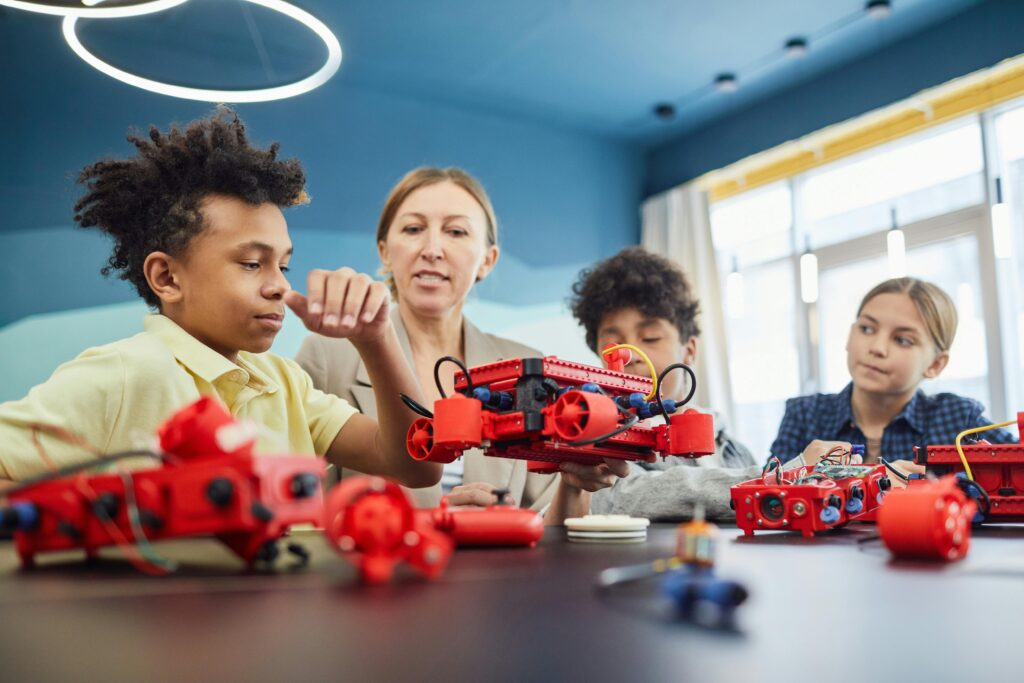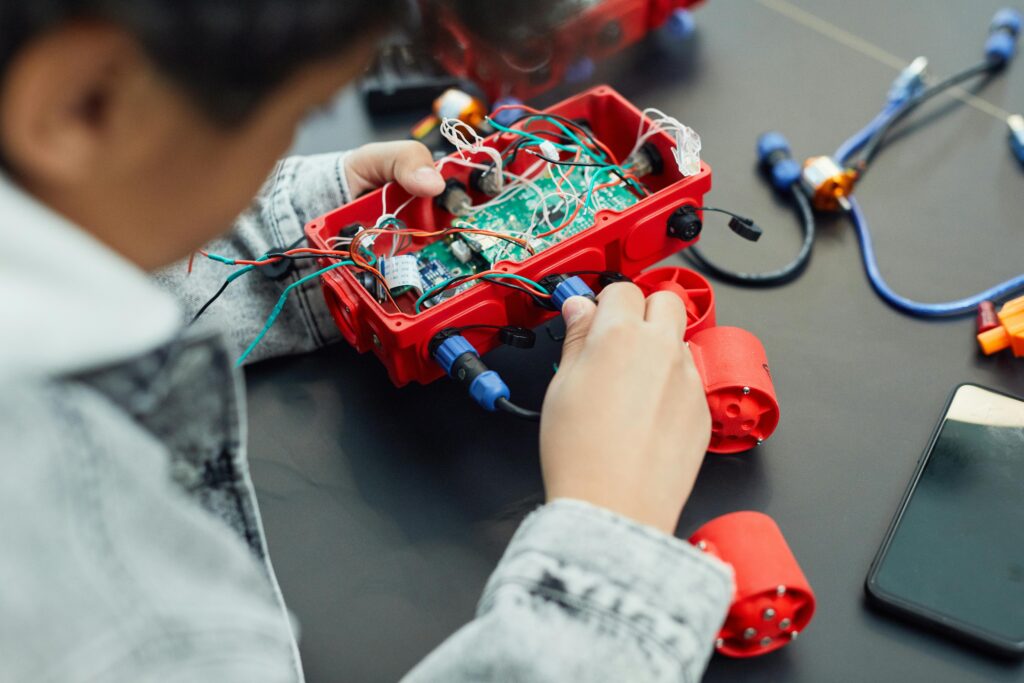Introduction
In today’s dynamic classrooms, fostering active learning is key to engaging students in learning, deepening their understanding and developing agency. Active learning strategies empower students to take ownership of their learning, shifting from passive reception to active participation. Research indicates that students engaged in active learning retain information at a rate of 25–50% higher than those in traditional lecture-based environments (Freeman et al., 2014). Collaborative learning and responsible decision-making play integral roles in creating equitable, effective learning experiences. By intentionally designing group activities and fostering ethical decision-making, educators can cultivate environments where all students thrive.
Engaging Students in Learning that is “Active”
Active learning is a powerful instructional approach that encourages students to engage directly with course material. Educators have seen firsthand how group dynamics can have an impact on student learning. Unequal participation and disengagement can hinder progress, but structured group activities with clear expectations can mitigate these challenges. By integrating hands-on experiences, problem-solving tasks, and real-world applications, educators can foster a learning environment by enhancing student engagement. This not only supports academic success but also nurtures curiosity and critical thinking! Research shows that implementing positive interdependence, structured turn-taking, and explicit reasoning prompts can create equitable and effective group interactions (Theobald et al., 2017). Studies have also found that students in active learning settings perform better on assessments than those in passive learning environments (Freeman et al., 2014), highlighting its effectiveness in boosting comprehension and academic performance. Furthermore, research suggests that active learning environments improve student confidence and motivation. A study by Prince (2004) found that active learning approaches enhance student attitudes toward learning, making them more likely to persist in their studies and engage deeply with content.
The Role of Collaborative Learning
Collaborative learning extends beyond traditional group work, fostering peer-to-peer instruction and collective construction of knowledge. This approach not only enhances classroom experiences but also prepares students for future professional workplace environments where teamwork is essential (Keith, 2023). Effective collaborative learning strategies include forming small groups of three to four students, assigning rotating roles to ensure accountability, and incorporating interactive discussions. Research suggests that students engaged in collaborative learning demonstrate higher levels of critical thinking, problem-solving skills, and long-term knowledge retention compared to those learning individually (Johnson & Johnson, 2014). These techniques result in greater student engagement, improved knowledge retention, and stronger interpersonal skills, all of which contribute to academic and career success! Furthermore, all of these are empowering teachers for success in meeting the needs of the learners in their classrooms.

Student perspectives on collaborative learning further reinforce its value. Studies indicate that students appreciate the opportunity to explain concepts to peers, which strengthens their own understanding. Research also shows that students in collaborative learning settings report feeling more connected to their peers, reducing anxiety and fostering a sense of academic belonging (Zhao & Kuh, 2004).
Student Learning Communities
Student learning communities (SLCs) are structured groups of students who work together consistently over time to deepen their understanding of academic content and build social-emotional skills. These communities create a supportive environment where students engage in meaningful discussions, share diverse perspectives, and collaborate on problem-solving tasks. Research indicates that SLCs contribute to academic success by fostering a sense of belonging, increasing motivation, and encouraging active participation in learning (Fischer et.al., 2021). A key component of successful student learning communities is the establishment of clear goals and structured interactions. Educators can facilitate these communities by incorporating reflective discussions, peer mentoring, and collaborative projects.
Longitudinal studies have shown that students in well-structured learning communities report greater academic persistence and higher overall satisfaction with their educational experience (Tinto, 2017). By nurturing a culture of shared responsibility and accountability, SLCs help students develop critical thinking skills, resilience, and adaptability—essential qualities for lifelong learning and success in diverse professional fields.

Enhancing Student Engagement with Responsible Decision-Making
Responsible decision-making is a critical social-emotional skill that enables students to make ethical, informed choices that impact both their personal growth and social interactions. It involves evaluating options, considering consequences, and reflecting on decisions. Effective decision-making strategies, such as active listening, structured turn-taking, and encouraging diverse perspectives, foster a respectful and inclusive learning environment (Fischer et.al, 2021). Encouraging students to engage in thoughtful dialogue and critical reflection prepares them to navigate complex real-world situations with confidence and empathy. The CASEL framework highlights responsible decision-making as a core competency in social-emotional learning. According to CASEL, responsible decision-making encompasses the ability to make ethical and constructive choices regarding personal and social behavior. This includes identifying problems, analyzing situations, considering ethical standards, and evaluating the impact of decisions on oneself and others (What is the CASEL framework?, n.d.). A meta-analysis of social-emotional learning programs found that students who developed strong decision-making skills through SEL-based interventions showed an 11% increase in academic achievement compared to their peers (Durlak et al., 2011). By integrating CASEL’s principles into student learning communities, educators can equip students with the skills to navigate challenges, resolve conflicts, and foster inclusive learning environments. The development of these decision-making skills not only enhances classroom interactions but also prepares students for future professional and civic responsibilities.
Empowering Teachers for Success with Active Student Learning

Active and collaborative learning are essential components of a thriving educational experience. By fostering group interactions, promoting peer-led instruction, and cultivating responsible decision-making, educators can empower students to become lifelong learners and effective contributors to society. Through intentional instructional design, classrooms can transform into dynamic spaces where engagement, collaboration, and ethical reasoning flourish.
References
Durlak, J. A., Weissberg, R. P., Dymnicki, A. B., Taylor, R. D., & Schellinger, K. B. (2011). The impact of enhancing students’ social and emotional learning: A meta‐analysis of school‐based universal interventions. Child Development, 82(1), 405–432.
Fischer, D., Frey, N., & Almarode, J. (2021). Student learning communities: A springboard for academic and social-emotional development. ASCD.
Freeman, S., Eddy, S. L., McDonough, M., Smith, M. K., Okoroafor, N., Jordt, H., & Wenderoth, M. P. (2014). Active learning increases student performance in science, engineering, and mathematics. Proceedings of the National Academy of Sciences, 111(23), 8410-8415.
Johnson, D. W., & Johnson, R. T. (2014). Cooperative learning in the classroom: Research and strategies. Interaction Book Company.
Keith, T. (2023, May 12). Collaborative Learning and Classroom Pedagogy, Part 1: Approaches to Successful Collaboration. The University of Chicago: Academic Technology Solutions.
Theobald, E. J., Eddy, S. L., Grunspan, D. Z., Wiggins, B. L., & Crowe, A. J. (2017). Student perception of group dynamics predicts individual performance: Comfort and equity matter. PLOS ONE, 12(7), e0181336.
Tinto, V. (2017). Leaving college: Rethinking the causes and cures of student attrition. University of Chicago Press.
What is the CASEL framework? (n.d.). CASEL.org. Retrieved May 18, 2024, from https://casel.org/fundamentals-of-sel/what-is-the-casel-framework/
Zhao, C. M., & Kuh, G. D. (2004). Adding value: Learning communities and student engagement. Research in Higher Education, 45(2), 115-138.

